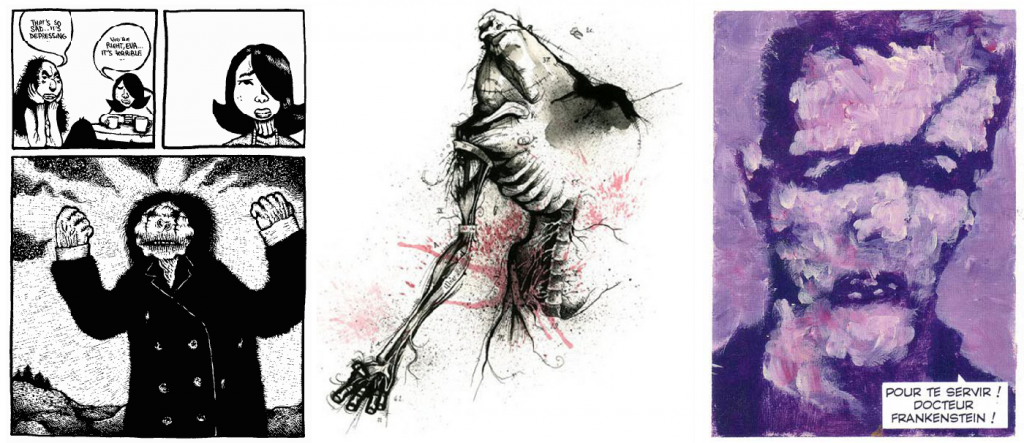The ACME Speaker Series Presents:
Conférence
« Frankenstein, une créature graphique
adaptations en bande dessinée«
interventions de Véronique Bragard (UCL)
et Logan Labrune (Bangor University)
Lundi, 4 janvier 2016, à partir de 14h
Local A2/6/11
Place du XX Août, Liège
 (c) Alex Baladi, Gris Grimly, Denis Deprez
(c) Alex Baladi, Gris Grimly, Denis Deprez
Assemblage, matérialité et abjection dans les adaptations BD francophones de Frankenstein
Cet exposé présentera les pistes de réflexion d’un travail en cours (en collaboration avec Catherine Thewissen) sur les réécritures francophones récentes du célèbre roman Frankenstein. Si le docteur Frankenstein abandonne sa créature, ce n’est pas parce qu’elle est est « laide » mais abjecte, qu’elle menace les contours de l’identité corporelle. Alors que le roman ne s’attarde que très peu sur cette question pour privilégier une intrigue philosophique sur la responsabilité, les productions Bds récentes en font la base-même de leur approche. Nous tenterons ici de voir la capacité et manière dont la BD peut appréhender la question de l’abject et de la déformité (disability studies) dans FrAnKeNsTein (2003) de Deprez et Frankenstein, Encore et Toujours de Baladi (2001). La matérialité du dessin renvoie à la matérialité déformée du corps fragmenté de la créature. Celle-ci devient posthumaine, monstrueuse et objet de dégout. Le lecteur devient alors celui-là même qui ressent le dégout et est forcé d’accepter cette chose qu’il voudrait lui-même exclure. La peur du monstre violent devient une peur du corps en putréfaction et déformation. Dans ce sens, la bande dessinée développe une toute nouvelle interprétation du roman.
Véronique Bragard is an Associate Professor in Comparative Literature at the Université catholique de Louvain, Belgium. Her current projects include the Belgian colonial past and Belgo-Congolese Literatures, and the representation of waste in world literatures and graphic novels. Her recent publications include »Belgo-Congolese Transnational Comics Aesthetics: Transcolonial Labor from Mongo Sisse’s Bingo en Belgique to Cassiau-Haurie & Baruti’s Madame Livingstone: Congo, la Grande Guerre (2014) Literature compass; “Melancholia and Memorial Work: Representing the Congolese Past in Comics” in Binita Mehta & Pia Mukherji (Ed.) Postcolonial Comics: Text, Event, Identities (Routledge: 2015), 92-110;“Conrad’s Two Visions: Intermedial Transgenericity in Anyango and Mairowitz’s Graphic Adaptation of Heart of Darkness” European Comic Art 6:1 (Spring 2013), 45-65.
It’s (Still) Alive! A Graphic Encounter with the Uncanny and a Shapeshifting Classic in Grimly’s Frankenstein
My talk focuses on graphic adaptations and more precisely on Grimly’s Frankenstein (Balzer+Bray, 2013). I would like to suggest that the graphic artist offers an ungraspable work of literature. This can, for instance, be argued aesthetically speaking as the American author uses an unaltered but abridged version of the text which is therefore familiar to the reader and yet thoroughly and intensely reworked both visually and ideologically. During this presentation, I will like to develop two main aspects. First of all, Grimly gives a very distinct voice to the creature which stands out from the rest of the characters in the book. However, this is not only because of its very organic and abject appearance when depicted, but also through the layout and panel construction when it recalls its own life. This graphic retelling focuses on the experience of life and on feelings as the body seems to reflect emotions and states of mind with the monster and its creator as shapeshifting and ungraspable individuals. Secondly, Grimly reworked Shelley’s canonical work and emphasized the uncanniness and the sense of otherness inherent to the Victorian novel. While the original book might be remembered mainly through the monster, this comics generalizes the eeriness to the whole environment with looming technological progress, an unsettling sublimation of the cities and a macabre art style crafting an even tighter relationship between life and death. To conclude, similarly to the fact that graphic adaptations reshape the canon, Frankenstein is reworked, sometimes developed but most importantly undeniably complexified in this haunting work.
Logan Labrune is a Belgian PhD candidate in French Studies as well as the Graduate Teaching Assistant for French at Bangor University (UK). His research focuses on graphic adaptations of literary classics and the formation of the cultural canon. He previously studied at the Université Catholique de Louvain (Belgium) where he wrote his MA dissertation titled Post- Punk Monsters: a Study of Graphic Instability and the Uncanny in Grimly’s Frankenstein.
The ACME Speaker Series is organized by the Comics Research Group ACME (http://www.acme.ulg.ac.be/) and sponsored by BeIPD-COFUND ULg.